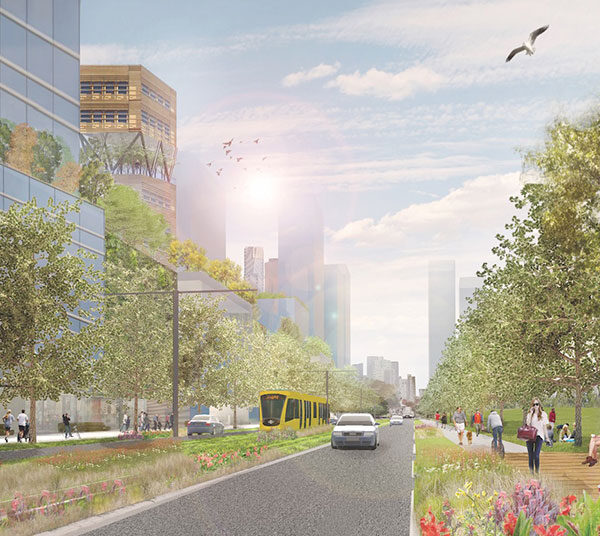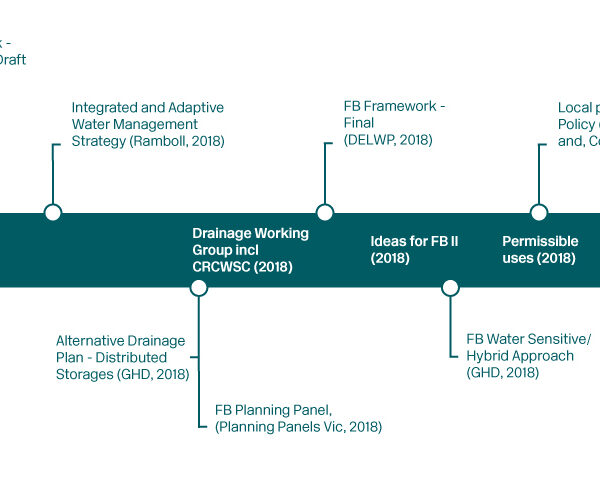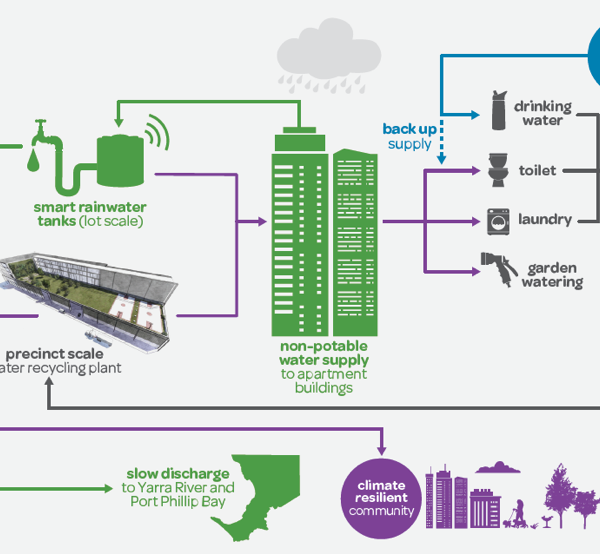Collaborative planning for the Fishermans Bend Urban Redevelopment
Contact
Insight:
Integrated water management requires partnerships that support collaboration, align cultures and build consensus. Sometimes, a catalyst is needed, such as creating a forum for sharing ideas, backed by enduring partnerships to bring these ideas to fruition.
The drivers
- Green Star rating The vision for Fishermans Bend to become Australia’s largest Green Star Community
- Sustainability Goals in the Fishermans Bend Framework
- No hotter than inner Melbourne
- Reduced nutrient discharges
- Sewerage discharges reduced by 50%
- Less than 100 litres of potable water used per person/day
- Reduced storm and flood impacts, including sea level rise - Constrained site Development that responds to significant environmental constraints including high water table, high levels of ground contamination, tidal and storm surge issues and projected sea level rise issues
- Exemplary urban design outcomes Desire to incorporate water in the landscape, and to facilitate an approach to finished floor levels in buildings that could support exemplary urban design outcomes
The innovations
The early identification of innovations that will define Fishermans Bend’s water management success across multiple scales
- Independently led co-design process The CRCWSC hosted a co-design process that brought together researchers, government and industry stakeholders in three workshops to discuss emerging research and international best practice. This process developed a number of ‘ideas’ for Fishermans Bend which could be tested and refined by project stakeholders (see Ideas for Fishermans Bend, CRCWSC 2015). The collaboration and innovation fostered through this process has been a hallmark of water planning for Fishermans Bend, allowing options to be explored in an environment where no individual organisation led or owned the conversation. This collaborative process led to the development of the following initiatives across the site:
Whole of Fishermans Bend scale
- Governance model A multi-stakeholder Steering Committee was established, comprising, Melbourne Water, South East Water, the City of Port Phillip, the City of Melbourne and the CRCWSC. A Drainage Working Group, established in 2018, reports to the Fishermans Bend Taskforce Board. This group of senior executives of key partner organisations prepared a water sensitive city strategy that informed infrastructure strategy, precinct planning and water related developer contributions for Fishermans Bend.
- Research + industry Continuing partnerships with research organisations (e.g. CRCWSC) and expert consultants (e.g. GHD) provide technical and innovation support. Importantly, these experts worked closely together and were embedded with stakeholder planning teams during critical phases.
Precinct scale
- Integrated water management strategy A strategy of ‘making water locally’ centres around a water recycling plant to provide Class A recycled water. Importantly, this plan could seed wider third pipe networks across the Melbourne CBD in the future.
- Flood resilience A ‘multiple-lines-of-defence’ flood management strategy includes WSUD, planning and building controls, social resilience, upgraded pipes and pumps capacities, and a levee along the Yarra River. Flood resilience is achieved when these elements work in unison, rather than requiring each to provide flood protection in isolation.
- Urban ecology strategy This strategy focuses on ecological values and ecosystem services in green corridors, public open space design and building design, to green, cool and naturalise Fishermans Bend.
Street scale
- Hybrid drainage infrastructure A hybrid drainage infrastructure approach uses linear green swales and parks, and combines with existing underground drains, to temporarily store and convey flood water. The hybrid principle extends to the function of the levee and pumps to ensure that (1) the green swales are placed in areas where levee over-topping is more probable and (2) water stored in green swales is efficiently drained to the Yarra River.
Lot scale
- Smart rainwater tanks Smart rainwater tanks allow for roofwater harvesting, while active discharge control ensures tanks are empty before an upcoming rain event.
- Flood resilient design Flood resilient buildings located in flood prone areas employ design and materials that are more tolerant of lower level flooding and are an alternative to raising floor levels. This approach allows for better building activation and better streetscapes.
- Third pipe plumbing All buildings will use alternative water sources (a mix of rainwater and recycled water) for washing machines, toilets and irrigation.
Project stats
Location
Melbourne, Victoria
Dates
May 2020
Participants
Topics
Contact
The outcomes
 Cities providing ecosystem services
Cities providing ecosystem services

-
Green infrastructure habitats—Distributed green infrastructure such as green walls, roofs and public spaces, will create new micro and macro climates within the urban area, greatly increasing biodiversity and health of the overall urban/green space ecosystem.
-
Water quality improvements—Distributed treatment of stormwater throughout the development will improve the health of downstream environments and groundwater reservoirs.
-
Urban ecology strategy—This strategy focuses on ecological values and ecosystem services in green corridors, public open space design and building design, to green, cool and naturalise Fishermans Bend.
 Cities as water supply catchments
Cities as water supply catchments

- Smart, integrated water infrastructure—More efficient water usage, sewer mining, rainwater tanks and third pipes will provide alternative water. These initiatives will also improve the quality of stormwater runoff, reduce water consumption and mitigate flooding risks.
- Integrated water management strategy—This strategy of ‘making water locally’ centres around a water recycling plant to provide Class A recycled water via dual pipe infrastructure to all Fishermans Bend South East Water customers.
 Cities comprising water sensitive communities
Cities comprising water sensitive communities

-
Collaborative co-design workshops—Participants at the multiple research synthesis workshops shared knowledge and actively contributed to developing ideas.
-
Design for the community—Implementing this variety of sustainable innovations in public spaces will greatly increase the community’s awareness of sustainability issues and increase their interest in looking after the development.
-
Community are part of the solution—Building social resilience is a key outcome of the flood management approach.
Interested in this solution?
We partner with small and large companies, government and industry in Australia and around the world.



Comments